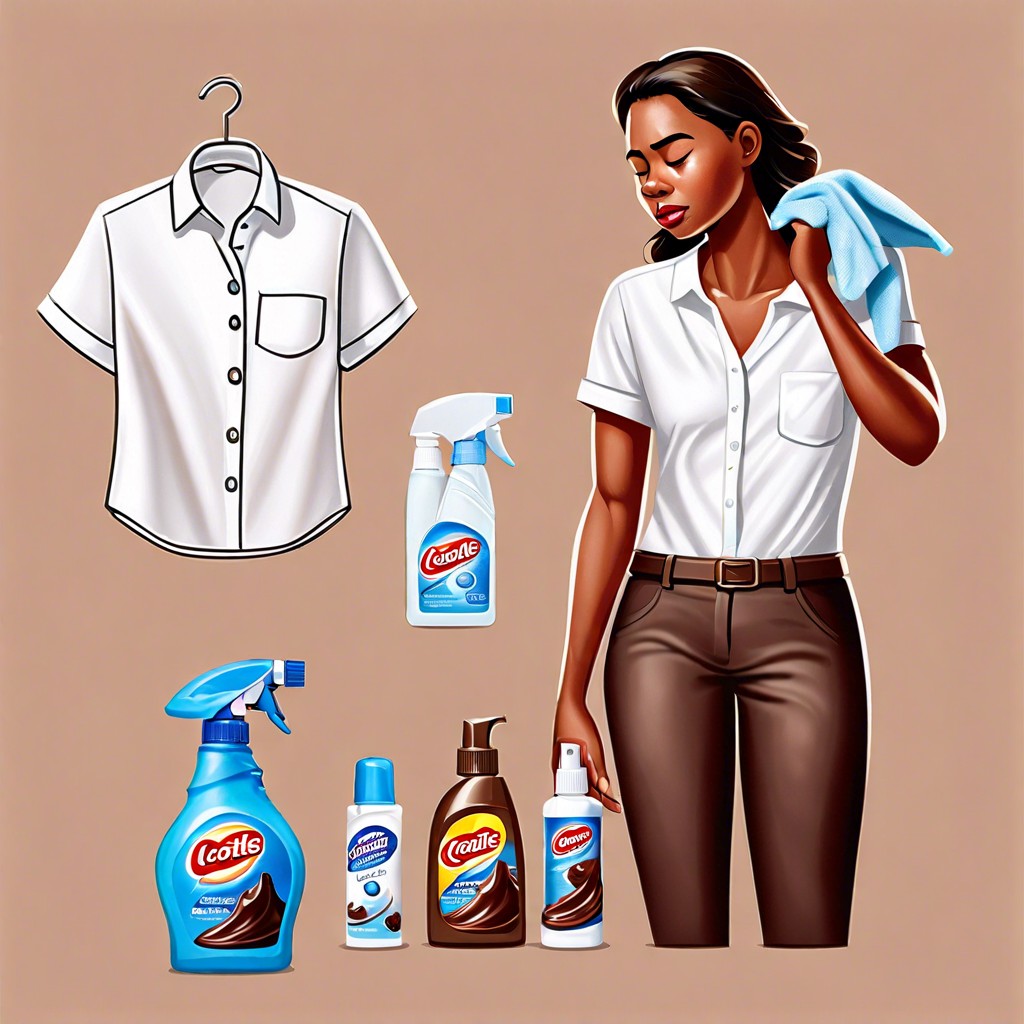Last updated on
Learn effective methods to remove chocolate stains from your furniture with simple household items.
Key takeaways:
- Promptly scrape away solid chocolate from fabric
- Use cold water to treat chocolate stains initially
- Dab or blot the stain gently, avoid rubbing
- Apply enzyme detergent and wash in hot water
- Consult a professional cleaner for delicate fabrics
Table of Contents
Before Getting Started: General Chocolate Stain Removal Tips

Tackling chocolate stains promptly is key. The longer a chocolate stain sits, the harder it will be to remove. Begin by gently scraping away any solid chocolate from the fabric with a dull knife or spoon, being careful not to spread the stain further or embed it deeper into the fibers.
Always use cold water when treating chocolate stains initially. Hot water can cause the chocolate stain to set, making it more challenging to remove. Test any cleaning solution on a small, inconspicuous area first to check for any adverse reaction with the fabric.
Avoid rubbing the stain harshly as this can damage the fabric’s surface and drive the chocolate deeper into the material. Instead, dab or blot the stain gently with a clean, dry cloth or paper towel. This method helps lift the chocolate from the fabric without spreading it.
Remember to check the care labels on your garments and textiles. Some materials may require special care or are only suitable for dry cleaning. In such cases, it’s best to take the item to a professional cleaner who specializes in stain removal.
Step 1: Remove Excess Chocolate
Begin by gently scraping away any solid chocolate fragments from the fabric using a spoon or the edge of a dull knife—care is crucial to avoid pushing the chocolate deeper into the material. Avoid rubbing the stained area to prevent spreading the chocolate. If dealing with melted chocolate, place the garment in the refrigerator for a few minutes; this will harden the chocolate and make it easier to scrape off. For small, delicate items, using the back of a butter knife or a credit card might be more suitable to remove the residue. Once the excess chocolate is lifted, you should be left with a lighter stain, ready for the next cleaning phase.
Step 2: Flush Stain in Cold Water
Begin by turning the stained fabric inside out. Direct a steady stream of cold water over the backside of the stain. This method helps to force the chocolate out of the fabric rather than pushing it deeper into the material.
Use gentle pressure, and avoid scrubbing, as this can embed the chocolate further into the fabric fibers. Continue to flush the area for one to two minutes to dislodge and remove as much of the chocolate as possible.
Cold water is crucial as it doesn’t set the stain — hot water can do the opposite, making the chocolate more difficult to remove. If you’re dealing with a delicate fabric that cannot withstand the force of running water, soak the stained area in a bowl of cold water, gently swishing it around for a few minutes. Then, lightly dab the stain with a clean cloth to help lift it out of the fabric.
Step 3: Apply Enzyme Detergent & Wash in Hot Water
Once the initial steps have been taken to address the chocolate stain, applying an enzyme-based detergent provides an effective solution for breaking down the proteins in the chocolate. Enzymes act as a catalyst, speeding up the reaction that helps to lift the stain from the fibers of the fabric. To use an enzyme detergent correctly, gently apply a small amount directly onto the stained area, carefully following the instructions on the product label.
Allow the detergent to sit on the stain for the amount of time recommended by the manufacturer, usually about 5-15 minutes, but never allow it to dry on the fabric. This time allows the enzymes to work their magic, breaking down the stain without damaging the material.
Next, wash the garment in the hottest water that is safe for the fabric, as indicated on the clothing’s care label. Hot water helps in rinsing away all the loosened particles and the remaining detergent. Just be cautious with delicate fabrics that may not tolerate high temperatures well; adjusting water temperature to suit the fabric care is key.
Once washed, inspect the affected area before drying. If any trace of the stain persists, repeat the enzyme detergent treatment prior to drying, because high heat from the dryer can set the stain permanently. Always air dry until certain the stain is completely removed.
How to Remove Chocolate Stains From Carpets and Upholstery
Carpets and upholstery demand extra care due to their fabric and inability to be tossed in the wash.
Begin by gently lifting away any solid chocolate with a dull knife or edge of a spoon, being careful not to grind the chocolate into the fibers. Vacuuming any dry particles helps prevent further smearing.
Blot the stain with a clean, dry cloth to absorb as much chocolate as possible. Avoid rubbing as it will push the stain deeper into the material.
Mix a solution of two cups of cool water with a tablespoon of liquid dish soap. Dip a clean white cloth into this solution and sponge the stained area. Start from the outside of the stain to prevent spreading.
Rinse the area by blotting with a wet cloth using cold water to remove soapy residue. Repeat the sponging and rinsing process if necessary.
For persistent stains, it might be necessary to apply a commercial upholstery cleaner or a mixture of equal parts water and white vinegar. Always test cleaners on an inconspicuous area first.
Once the stain has lifted, blot with a dry cloth until the area is dry. Patience is key; for deep stains, multiple applications may be required.
Remember, with delicate fabrics, it’s recommended to consult a professional cleaner to avoid damage.




